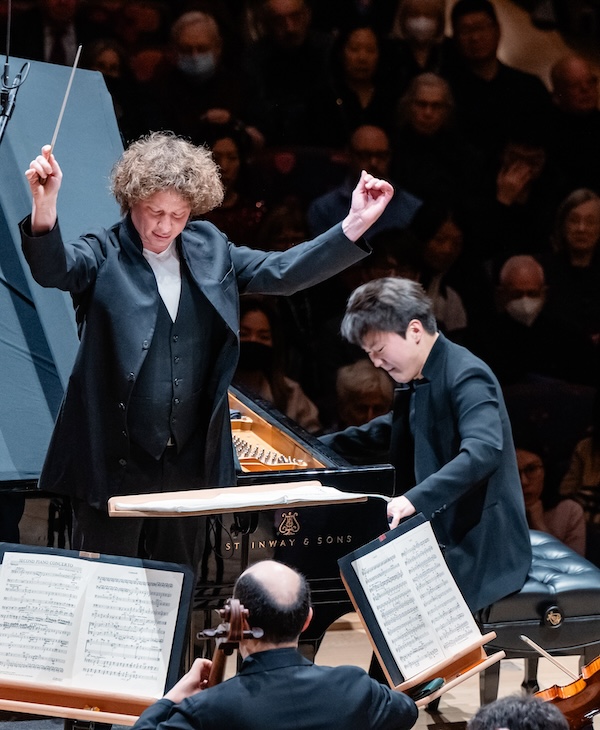Prokofiev, light Shostakovich fare better than the dark side with Philharmonic

Call it the Two Face concert.
This week’s New York Philharmonic program, which opened Thursday night in David Geffen Hall, featured two sides of a pair of the greatest 20th century composers, Shostakovich and Prokofiev. With guest conductor Santtu-Matias Rouvali at the podium, the evening opened with Shostakovich’s public and populist Moscow, Cheryomushki and his private, profound Symphony No. 15 after intermission. In between, pianist Seong-Jin Cho joined the orchestra for Prokofiev’s Piano Concerto No. 2, a piece that swings back and forth between romanticism and modernism.
And in binary fashion that fit into the programming, half of this concert was absorbing, and the other half deeply disappointing.
The first half was the good half. Moscow, Cheryomushki is a satirical little piece from the late 1950s about housing shortages in the Soviet Union, and the suite (arranged by Andrew Cornall) distills music from the operetta into four sections. The Philharmonic played three of these: “A Swing Through Moscow,” “Waltz,” and “Dances.” Shostakovich, who was a silent film accompanist as a young man, knew how to write crowd-pleasing music, and that’s what this stylish suite does, in music full of exuberance with a cinematic/narrative quality to it.
The performance was excellent with a little bit of edge that touched the sub rosa mania in Shostakovich’s thinking. The swing through Moscow was like a cab marauding through the streets in a screwball comedy, the two dance movements just at the edge of exhaustion. Colors were bright and articulations were exact and punchy.
Part of the mixed nature of Prokofiev’s Second Piano Concerto is that it is both a student work and a mature work. The original 1912 score was destroyed during the Russian Revolution, and Prokofiev had to reconstruct in the 1920s. It’s big (four movements) and demanding (two cadenzas) in a. Canvas that alternates between soloist and orchestra working together and traveling in different directions.
That’s the case from the start, with miniature orchestral announcement giving way to the central piano part, which moves toward a massive cadenza that takes up almost half of the movement. The large finale has the other cadenza, while the smaller internal movements have strict purposes; Scherzo and Intermezzo.
The romanticism is in the solo part, and Cho pressed this to the breaking point. His playing was Lisztian in the outer movements, not just in the pianism but the way he kept building expressive force and weight. It was thrilling to hear him play the first cadenza, he seemed almost literally to be constructing the music in a series of vaulting steps leading to plateaus, with each one striving higher than the last. Each time it seemed he had hit the music’s limit, he surpassed it.
He showed further artistry in the following movements, with a strictness in the Scherzo, and a subdued manner and rich tone in the Intermezzo. Grandiosity and ferocity return in the final movement, and Cho not only maintained his stamina but seemed to have even more energy, and a subtle lightness to his touch that balanced the weight of the first movement. With the piano and orchestra chasing each other through much of the movement, Cho had a pointed bounce to his playing.
There was a touch of the Ravel he has mastered in this deeply impressive performance. He rounded that off with his encore of the French composer’s miniature À la manière de Borodine, a delicate and succinct period to this appearance.
Technically, the symphony performance on the second half was fine, with precise playing from the orchestra and Rouvali carefully managing tempos and shaping dynamics and balances. But playing all the notes doesn’t mean playing the music, and this was a Shostakovich piece with barely a trace of the composer and his expressive, intellectual, and moral ideas.
We are perhaps losing the cultural memory of Shostakovich’s world, which could explain why Rouvali showed no understanding of the music. The composer had to carefully modulate his music so it could show a shadow of what he was thinking while keeping him out of the Gulag, and it is the shadow that is essential. The music is as orderly as Buster Keaton’s expression, and like it requires steady tension and an understanding that things like happiness and fear can be expressed in the same way.
There was almost no tension in this performance, even in the dark Adagio movement, and so much of it felt empty, even boring. Rouvali’s interpretation was overwhelmingly obvious, pushing toward a romantic and narrative sweep, but without charm or nuance. The sincerity and mysteries in the music were absent, the intriguing puzzles of the Wagner and Rossini quotations fell flat, the strange conclusion came off as cute. Shostakovich is a double-edge blade, one side for creating, the other for destroying, both equally sharp. For Rouvali, the symphony was just a hammer, and the results just as dull.
This program will be repeated 7:30 p.m. Friday and Saturday. nyphil.org